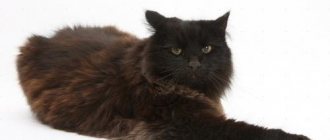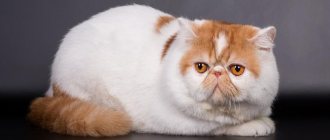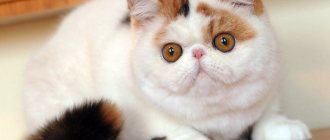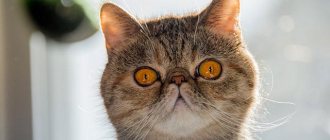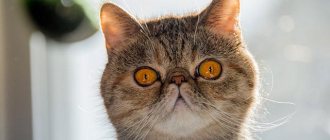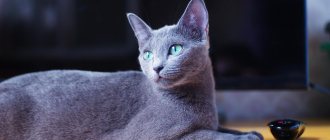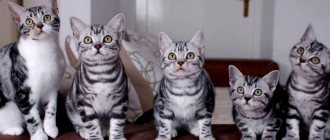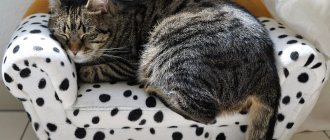Home » Breeds » About the exotic cat (exotic)
There is not only one exotic cat on the planet. Man himself strives to surround himself with exotic pets, obtaining them through the hybridization of some felines to others. Moreover, the more unusual the “child of a hybrid” looks, the more interesting it is for breeding and the greater the demand for its distribution.
More than one exotic cat has already been bred in a similar way: Savannah, Chausie, Caraquet, Ussuri, Kanaani, etc. Judging by the last two, people can no longer stop, and continue to invent new breeds, mixing already established hybrids.
However, such a thirst for “something new” often has a negative impact on the health or appearance of animals, leading to irreversible consequences, in particular, non-viability.
Exotic shorthair cat - exotic
An exotic cat , born due to chance, is a true miracle in the cat world. A touching face with a childish, even slightly offended expression, chubby cheeks and round paws - the breed received a standing ovation from numerous fans. A playful and loving exotic cat deserves to learn more interesting information about him!
History of the origin of exotics
Today the exotic cat is included in the lists of popular and favorite breeds. And these amazingly cute cats turned out as a result of failure in the process of experimental selection. According to the letter of history, breeders decided to cross a Persian with an American Shorthair to get a greater variety of colors. But the result was not a Persian, not an American, but wonderful plush, almost toy-like, exotic kittens.
From the Persians they inherited the pretty expression of a childish, doll-like snub-nosed muzzle. They got their plush fur from their short-haired ancestors.
Strange, but the origin of these cuties was not very well received by supporters of purebred crossing, seeing this as an attempt to change the phenotype of the Persians. Fortunately, there were also admirers of the new breed, and soon work began on breeding a population of plush short-haired exotics. Not only the above-mentioned cats took part in it, but also Burmese and Russian Blue. Today they are recognized by the World Cat Fanciers Association.
Pregnancy
Experts recommend mating Persians in the dark. A cat, like any female individual, prefers an attentive gentleman, and here certainly nothing depends on the number of exhibition awards or titles. It has been proven that the quality of Persian kittens that are yet to be born depends on the correct choice of cat and cat owners.
The pregnancy of a Persian cat almost always goes without problems. Childbirth can bring unpleasant surprises, so you need to worry about getting all the information in advance. Be prepared to help your cat: mating usually occurs without assistance, and a cat's pregnancy may require increased attention from the owner and supervision from a veterinarian.
Problems during pregnancy and childbirth are different:
- The cat is suffering from bouts of vomiting
- She eats much less
- The animal has a fever
- The animal becomes lethargic
If a cat does not eat anything for more than a day, then this is a reason to immediately seek help!
Description of exotic cats
Before we begin to describe the cat, it should be clarified that exotics are included in the same subgroup with Persians and extreme cats, but these are three different breeds. Many people still consider the exotic cat to be a type of Persian. But even though the ancestors of the cat with a cute face are Persians, and their standards are very similar, we are talking about a separate breed.
Based on the accepted characteristics, you can easily determine the breed of a cat with a flattened muzzle.
This pet has a rounded head. A feature of cats is their snub nose with a “stop”, which is very short. The breed's cheeks appear full. The small ears have some slant. The eyes adorn the cats' faces: round and very large eyes make the expression of the face almost childish.
The neck looks short and thick.
Pets stand on thick, strong paws. The small skeleton is tightly knit, the body looks massive. The body appears stocky and squat.
There are tufts of fur between the toes on the rounded paws. The limbs are massive and strong.
The tail is short and well-furred, the tip is necessarily rounded, and the tail is set low.
The fur of exotic pets is literally plush and fluffy, soft and short, the undercoat is very thick. Only homozygous short-haired exotics always give birth to the same cuties with short hair. Otherwise, the offspring may also include long-haired newborns, which, however, will turn into gorgeous adult fluffy cats.
The heir of the short-haired cat is included in the list of breeds that can cause allergies.
Exotic cat colors are variable and varied. Here are a few of the most common:
Slight variations in color shades are possible. The most popular animal of this breed is the cat Snoopy.
Dimensions and weight of exotics
Exotic cats look somewhat smaller than cats in length, size, and height. The weight of females is also slightly lower than the weight of males: on average, adult offspring of Persians and American females weigh from 3.5 to 7 kg.
How much an exotic animal weighs is not so important according to the standard: in any case, it is an animal of medium or large size if it is sterilized or neutered.
Habits and character of exotic cats
Although a cat of an exotic breed resembles a clumsy bear cub, it is actually a very active and playful creature. Teddy cats are very sociable, friendly and affectionate in nature.
There is no need to worry whether the exotic will get along with dogs and other cats. Reviews from owners about his friendliness indicate that the affectionate cat will not offend other pets, and he himself serves as an adored creature.
Other good character traits include a cheerful disposition and curiosity. But you need to keep an eye on your exotic pet - a cat’s curiosity sometimes has no limits, and its sense of danger lets it down. If you don't pay attention, the animal can accidentally hurt itself by playing where it shouldn't. Potentially dangerous places should be kept under control.
This breed is ideal for families with children, with whom the moderately phlegmatic exotic purr will get along well. An affectionate friend will happily listen to the owner’s monologue, even if it is a many-hour description of all the sorrows that happened during the day. An exotic kitten will not refuse to play outdoor games. Growing up, he still won’t be able to resist playing with a piece of paper or a ball. Playful habits persist into old age.
Those who aren't too keen on loud-talking cats will be happy to know that these teddy bears are quiet. This is probably due to the peacefulness and calmness of exotics - it is quite difficult to anger such a cute animal.
The exotic cat is smart , so it can be trained and learned well. In order for the upbringing and learning process to bear worthy fruits, they should not be delayed. A kitten of this breed must be raised from the very beginning. All commands can be simplified, and at the same time, while pronouncing them, clap your hands softly.
Aggression is not acceptable during training, since the psyche of exotic cats is very susceptible. The cat’s trust cannot be undermined: if the kitten has no desire to follow commands at the moment, there is no need to force him.
Cats easily master the litter box and get used to the scratching post, which makes their existence in the house almost problem-free.
Predecessors of the breed
Somewhere in the 50s of the last twentieth century. American breeders began to form their own “unique” breed from the well-known and popular breed of Persian cats - cats with a flat muzzle and a highly deformed skull like a Chinese dog - the Pekingese. As a result of the work, two new types of short-nosed Persian cats were obtained:
- With a strongly shortened, raised bridge of the nose, in which a line drawn through the upper point of the lobe coincides with a line drawn through the edges of the lower eyelids of the eyes. The eyes should be wide open - short open type, and the animal should not have a frowning expression on its muzzle. Open type.
- Here, the bridge of the nose is shortened so much that the line drawn through the upper border of the lobe should be 2-3 mm above the lower edge of the eye and not fall below the inner corners of round, widely spaced, straight-set eyes. Ideally, the stop of the bridge of the nose should coincide with the line of the upper eyelids. Exotic type.
The second type caused a lot of criticism: this form of the skull structure led to deformation of the tear ducts and their improper functioning, deformation of the jaws and teeth, and most importantly, to brachycephalic airway obstruction syndrome (excessively labored breathing). Yes, of course, open-type New Persians had the same problems, but as a percentage of the exotic type, they could be “not noticed” - they were so rare.
In exotic New Persians, brachycephalic syndrome led to changes not only in the shape of the nose, but also in the larynx and trachea, which affected breathing and, ultimately, the general health of the unfortunate animal. Moreover, this situation only worsened with age; in advanced cases, surgical intervention was required. Not only age, but also infection, stress, overheating, physical activity, and obesity could hasten the onset of an unpleasant moment.
Many breeders flatly refused to register and accept such exotic species for breeding, but there were also those who accepted this “miracle of felinology” with delight.
No reasonable arguments that this type of Persian was bred exclusively through harsh and ill-considered inbreeding, where exactly the same shortcomings of relatives served as “desirable characteristics” of the future breed, did not “reach out” to those who already saw a “gold mine” in this type " This exotic type of American Persian cat very quickly became preferable to the “classic” and “open” ones, due to its unusual “cuteness”.
Care and feeding of exotic cats
Although the breed is considered unpretentious, it still needs to be looked after. First of all, soft wool deserves attention. Fur coat care consists of combing with a steel comb to remove dandruff and already fallen hairs. The coat responds gratefully to bathing, so you can wash your exotic shorthair cat once a month with special cat shampoos.
Your cat also needs to clean its ears once a week and wipe its eyes daily with a damp cotton pad. Claws are trimmed as they grow.
Keeping exotic animals requires adherence to a 50/50 feeding scheme: natural food is combined with ready-made food. Only natural food is not welcome; it is better to choose premium dry food. In the finished food, the composition is already balanced and selected taking into account the age, breed and condition of the animal.
There should always be fresh, clean water in the bowl, and food should be placed three times a day. It is very important to feed the animal in portions, since the breed is prone to obesity, which is not so easy to combat.
In addition to nutrition, medications are recommended to remove hairballs from the stomach.
Territory and timing
Mating of Persian cats can occur both in the territory of the female and in the territory of the male. Some owners prefer neutral territory, and this choice also has a right to exist. It is important that both participants in the process are healthy and do not show aggression or fear, and that the heat occurs without complications.
It is not difficult to discern the time of mating. With the onset of heat, the cat becomes affectionate, constantly rubs against her legs, makes inviting sounds, rolls on the floor and does some unusual things for her. Estrus lasts plus or minus a week and has external signs that are not difficult to notice. If the mating was successful and fertilization has occurred, all signs of estrus will simply disappear the next day.
Exotic health
Exotic cats have similar diseases to Persian cats. This includes possible difficulty breathing, problems with the sinuses, sometimes obstruction of the nasolacrimal duct and watery eyes. These diseases have causes only in the anatomical structure of the muzzle, namely due to a shortened and flattened nose.
Eye diseases in representatives of an exotic breed can arise due to neglect of the rules of care, as well as due to a predisposition to this. Alarming symptoms such as brown tears, redness, brown spots, and cloudy eyes are a reason to consult a doctor.
In addition to problems with the nose, there is a possibility of dental diseases: gingivitis, tartar formation, periodontal disease.
It makes sense to check the health of the cat’s kidneys and heart at a young age.
Many health problems in the breed can be easily avoided if all vaccinations are administered on time; a caring owner will not neglect the vaccination of his pet.
If the cat was purchased for breeding, then there are practically no problems: the pregnancy goes smoothly and lasts 63-66 days. When the owner does not want to become a “grandparent” to adorable kittens, the exotic pet should be spayed or neutered. The recommended period for the procedure is 9-12 months.
How long do exotic cats live?
The lifespan of exotic cats at home depends on the genetic health of the pet and the care it receives from an attentive and loving owner. Careful adherence to feeding rules, timely vaccination on schedule and contacting a veterinarian in case of illness significantly increase the chances that a plush cat will live a long life, by cat standards.
Cats of this breed live about 13-15 years, and castrated animals noticeably longer.
How to choose a cat
You need to look for a cat for mating in advance, so that at the right time, the cat’s owner can accept your cat out of turn, since you need to breed a cat at a certain time for this, and it is very limited, especially if the mating is for the first time.
Finding a cat will not be difficult if you have a cat with a pedigree and is a member of the club. To do this, you will need to contact the club in advance, where they will give you a referral for mating and find a suitable groom.
If the cat is not a club cat, then you can find a cat through an advertisement, or you can also contact a cat club. At the same time, do not forget that having a veterinary passport and all necessary vaccinations is mandatory. Presumably 2 weeks before mating, the animal needs to be treated for parasites, the ears should be examined and the eyes should be tidied up if you have problems with this.
Shortly before mating, namely with the appearance of estrus, the cat’s claws need to be trimmed, and the cat’s owner does the same. This measure will help minimize injuries that often occur during the first meeting.
You should not bathe the animal, as this can discourage the attractive smell of “cat in heat” for the cat, in addition, it is unnecessary stress for your pet. You need to breed a cat from the 3rd to the 5th day of estrus inclusive, the remaining days are empty, that is, all matings that take place earlier and later than the specified period will not cover the cat, so you will never get kittens.
Mating should always be on the groom's territory. Since the cat feels insecure in the cat’s territory and may completely refuse to breed the cat. At the same time, it is very important that the cat has experience in “amorous affairs”; if the two animals are not untied, then nothing good will come of it.
With you for mating, you need to take bowls, a tray with filler, food for the cat and preferably some other toys so that the cat feels more confident, since her smell remains on her things.
If the cat is not untied, then you need to bring her to the cat from the first day of estrus, since she will need additional time to get used to the new environment and the cat. As a rule, this takes 2-3 days, then the cat will be ready for a closer acquaintance with the cat.
The cat owner must provide assistance during mating, if necessary. But, as a rule, for a successful mating, the animals simply need to be given time to get used to each other. If a cat shows aggression, then you should not force it to meet the cat. On the contrary, she needs to be placed in a separate room so that she can get used to the new smells and calm down.
Buy an exotic kitten
To find out how much an exotic cat kitten will cost, you should understand what its price consists of:
appearance, compliance with the description according to the standard;
“purity of blood” - kittens from parents with the title of champions are many times more expensive;
rarity and beauty of color;
care activities carried out by the breeder, including medical examination, sterilization, castration and vaccination;
seller: elite nurseries with a good reputation guarantee the purity of the breed, but kittens sold on Avito, Yula and other free trade sites may cost less. Please be aware that such a purchase does not come with any guarantees.
Thus, the absence of a pedigree reduces the cost of a cat - it is quite possible to buy a supposedly exotic cat, and when its fur, cut by an unscrupulous seller, grows back, it turns out that it is an ordinary Persian cat.
buy exotic at a price of 15,000-50,000
rubles
Nicknames for exotic cats
The purchase of a kitten immediately forces the owners to start coming up with a suitable and beautiful nickname for it. To choose the right name for your fluffy bundle of joy, there is no need to rush.
Cats get used to a good nickname quickly and react well to it. It is believed that a meowing friend only hears the first three sounds in his name. If you are guided by such information, then you should choose nicknames where the first part of the name will set the tone. Otherwise, the cat will respond better to “kitty-kitty” than to the name given by the owners.
The character and color of the young big-eyed purr also plays an important role in such an important matter.
To decide what to name an exotic boy or girl, you should first familiarize yourself with the best names.
Payment for mating
If the cat is a club cat with all the documents, then mating is carried out only under an agreement, which is drawn up exclusively at the club.
Before registration, payment and terms of mating with the cat staying with the cat are agreed upon. Before drawing up a contract, a groom is selected for a certain cat in accordance with genetic data, which will help produce better offspring regarding not only the health of future babies, but also color, etc. d.
Before the contract, all possible shortcomings of the cat are carefully studied by the cat’s side; perhaps the cat has a certain dominant gene that will be passed on to future kittens. This is done to avoid possible disputes and claims after the babies are born.
If cats without documents are mated, then all the conditions of both owners are discussed verbally, and all claims after mating will be meaningless, since the owners of the cat do not have a mating agreement in their hands.
Basic moments
- The exotic shorthair cat is a fairly young breed, but has managed to become popular all over the world.
- The animals were obtained by crossing American Shorthair and Persian cats. The characteristic appearance of the Persian combined with the plush structure of thick soft fur are the main features of the exterior of this amazing creature.
- Representatives of the breed get along well with children and other pets and willingly devote time to outdoor games.
- Exotics are peaceful, friendly and patient, which allows us to call the breed one of the safest for home keeping.
- Exotic shorthair cats are easy to train and can even follow simple commands.
- Exotics are very smart and train well. They are distinguished by an increased need to be in society, which is not typical for many of their relatives. These sweet creatures simply suffer from loneliness.
- The animals are unpretentious in maintenance and care, and are distinguished by fairly good health.
The Exotic Shorthair cat is a dream come true for many people, thanks to its large expressive eyes that make it look like an anime heroine, cute snub nose, round face and plush fur. Exotics are like soft toys that you want to play with all day! Due to their lively mind and natural curiosity, representatives of this particular breed with enviable regularity become the heroes of humorous videos. Exotic cats are sociable and completely non-aggressive, so they are suitable for families with children or pets.
Proper organization of mating
The rules for mating Scottish cats consist of the following points:
Pet owners also need to decide on whose territory the Scottish breeding will take place in order to prepare the premises. Traditionally, the cat plays the role of “master,” but this issue can be discussed.
If the “groom” is already untied and has experience, then he almost doesn’t care in what territory the mating will take place. The same rule applies to cats - at first they do not yet know what to do, but later they cope with the task perfectly in any room.
Important! The mating process lasts for several days. At this time, the owner of the apartment must control the behavior of the cats and ensure that they do not harm each other.
History of the Exotic Shorthair cat breed
The appearance of the exotic shorthair breed dates back to the 50s of the last century. Frankly speaking, the first kittens appeared completely by accident. Wanting to get new coat colors and eye colors, American Shorthair breeders crossed their pets with Persian cats. Another goal of these attempts was to make the physique of “American women” more dense. The task was not solved. The offspring, to the surprise and disappointment of the breeders, turned out to be very “Persian” - all the animals were born with characteristic “doll” faces. And in other respects, the kids were more like their parents “from the East.” Only the fur became noticeably shorter and acquired a denser, plush structure. As a result of crossing, it was not possible to improve the American Shorthair cat breed, but completely new kittens with an outlandish appearance were born.
Persian cat and diet
Properly organized nutrition for your pet will immediately affect its appearance, as evidenced by photos of Persian cats and their kittens shared by happy breeders. The pet will radiate health, its eyes will be filled with a lively sparkle, and you can completely forget about problems with the gastrointestinal tract. To help your cat live longer, try to treat her only to high-quality foods, avoiding table food that contains various herbs and spices.
A significant portion of the Persian's diet should consist of proteins, which account for an average of 35% of the daily diet. Protein feeding consists of boiled fish, lean meats, dairy products, cheese and eggs. It is advisable to add vegetables and legumes to them.
Carbohydrates are needed in small quantities for cats, so porridge for breakfast will serve your pet well. It will gently cleanse the intestines and improve its microflora. If the animal refuses to eat boiled cereal, you can use a little trick and add oatmeal to a bowl of milk. Or mix cereal porridge boiled in water with fish. It is important to remember that mixing cereals and meat is undesirable, as this can lead to stomach upset.
Food for Persian cats will be an excellent addition to the daily diet, but it is important to follow the pattern and not mix wet and dry types. They are digested differently by the body and can make your pet feel unwell. The best option would be to alternate “wet” and “dry” days.
Why are some animals able to live long lives, while others face diseases that affect years of life? The answer lies not only in the genetic predisposition of individual animals, but also in the quality of their diet. Try to provide your pet with a balanced diet, and then he will delight you for many years.
Exotic appearance
The ideal Exotic Shorthair cat appears to be a well-balanced animal with strong, even somewhat heavy, bone structure. The coat gives the outline softness and roundness, the expression of the muzzle conveys complacency and calmness of character.
Head
Round in shape, quite massive. The skull is very wide with a round bone structure. The chin is well developed and round in shape. The jaws are strong and wide, the cheeks are full.
Eyes
The eyes of an exotic cat are located far from each other at the same level. The shape is large and round.
Small size, round shape. Set wide and low on the head, slightly tilted forward. Not very open at the base.
Wide, short and upturned. “Stop” is located clearly between the eyes.
The body of exotics is medium or closer to large in size. Squat, with well-developed muscles, without signs of obesity. The chest is wide, the shoulders are massive.
Limbs
Strong, short, massive. The front ones are straight, the rear ones are straight when viewed from behind.
Exotic paws are large and round. There are 5 toes on the front paws, 4 on the hind paws.
Tail
Proportional to body length, although it can rather be defined as short. No bends. The animal is held at a level below the back.
Wool
The exotic cat's coat is thick and plush, with a rich undercoat. Middle length. It feels very soft to the touch.
Disqualifying features
Visible weakness of the hind limbs, tail defects, number of toes that does not meet the standard. Strabismus, asymmetry of the muzzle or head. Visible deformities of the spine. White toes and non-blue eyes for color points.
History of the origin of the breed
The exotic shorthair breed was bred in the USA in the 60s of the last century. It was then that American breeders decided to breed a Persian cat with better quality hair by crossing with an American Shorthair cat. However, the result of the experiments was a Persian shorthair cat, and surprisingly cute, with “stuffed” hair.
The exotic breed was officially “born” in 1966 with the light hand of Jane Martink. The striking hybrid was impossible to ignore, and the Cat Fanciers Association recognized them as a breed. The exotic breed was called “sterling” because its representatives had a silver color, but later the name was changed to “exotic shorthair cat”.
Features of the breed in 1973 became the characteristic upturned nose characteristic of Persians. Subsequently (from the beginning of the nineties) the standard of exotics and Persians became the same, with the exception of fur features.
Exotic shorthair cat
The Exotic Shorthair breed is a combination of the genotypes of the Persian cat and the shorthair cat. The result was a short-haired Persian with structural features and coat length, strongly reminiscent of the British, but with a snub nose and an excellent character.
As a result of crossing, the fur became soft and “plush”. Smooth-haired Persian cats received the best qualities from the original breeds. Plush exotic has a massive bone structure and excellent muscle structure.
Exotic Longhair
The exotic longhair cat appeared by chance during the period of selection of the classic shorthair. The Persian cat passed on more of its genes to this variety and endowed it with all its attributes: fur, appearance, character.
The Persian Exotic competes as a Persian, but is recognized as a variety of Exotic Shorthair.
Male choice
At first glance, it seems that choosing a male is not such a difficult question. You need to look at the pedigree, choose the desired color, wait for the heat, carry out the mating - and that’s it, the job is done. But in fact, everything is a little different:
- Free cats are individuals who are mated with almost any cat, if it is not related through the breeding line.
- Cats that mate with a limited number of cats. They are called limited or breeding, but you will have to wait a long time for such a beauty.
- Cats that participate in breeding in only one cattery. These individuals are inaccessible to other cats.
In any case, the main task is to choose a cat with a good pedigree, and also not to look for the most ideal male. In the search for the ideal mating, you can overlook good breeding potential.
An ideal purebred male often gives birth to defective offspring
Description and breed standard
According to the standard, exotic cats are quite large in size with an average weight (a cat in normal condition is about 6.5 kg), due to their large build. Exotic domestic cats look round and massive due to their densely packed coat.
The characteristics of the breed are similar to Persian standards, but there are distinctive features. The exotic cat has the following standards:
- medium sized rounded head;
- round large eyes, widely spaced;
- the nose is small, snub-nosed, located almost between the eyes;
- neat small ears;
- “drooped” cheeks;
- massive rectangular body;
- strong limbs of medium length with large paws;
- short, rounded tail in proportion to the body.
There is a subspecies of the breed - exotic extreme. These cats are prized for their particularly beautiful colors and have a more “Persian” nose. Until now, this breed of cat is exotic, and this is one of the components of the success of charming pets.
Color
The appearance of exotics is varied. They got their colors from the Persian breed and can be either single-color or two or three colors. The marbled color is considered quite common, in which distinct stripes are observed on the animal’s body.
In white exotics, additional shades or spots on the coat are not allowed. The red tabby looks very original, where a red or deep red pattern is visible on a beige or red background.
Black fur is also quite common among exotic Persians. The cat has no light spots, its fur is jet black. The blue color is no less popular; the fur of animals is gray and has a blue tint.
First mating
You need to breed a cat for the first time no earlier than the cat goes through her first heat, and it is very important that the animal is mature and healthy. A cat should be bred no earlier than one year of age, since the animal’s body is still growing until about a year old. And if you breed a young cat, you can greatly harm its health. As a result, kittens may be born non-viable, while the cat's growth will completely stop, and it is good if the birth is without complications. Before mating, you are obliged to give the cat all the necessary vaccinations and worm the animal, treat the ears if necessary, since it will be impossible to do this later. If this is not done, then all sorts of diseases that the cat has will be passed on to the babies; accordingly, the offspring will be weakened by possible diseases and parasites, which will have a bad effect on the development and weight gain of the kittens.
Meanwhile, it is not worthwhile to tighten the mating too much, the animal will be severely exhausted, both physically and psychologically. At the same time, the longer you put off mating, the less likely it is that the cat will be able to mate with the cat.
As a rule, cats that come to mating too late, that is, at 2 or 3 years old, behave extremely aggressively with the cat, as a result, such matings are of no use. Because the cat simply won’t let the cat near her.
In addition, delaying mating has a bad effect on the health of your pet, since all this can result in polycystic disease, which can lead to forced surgery in order to avoid health complications. So don't delay it.
Choosing a kitten
Most often, people fall in love with an exotic baby at first sight, so they don’t experience any particular difficulties with the choice. From childhood, exotic kittens are distinguished by their cuteness and resemblance to a plush toy. However, you should pay attention to the animal’s documents and its pedigree. It is advisable to purchase a kitten from well-known nurseries or from trusted breeders to be sure of the health and breed of your pet.
Not very honest breeders sell British dogs under the guise of exotics, often mixed with Persians. However, such a British exotic will not be a representative of the breed. The first show disqualifies the animal due to non-compliance with the standard.
There are also crossbreeds such as the exotic fold, when a Scottish fold is crossed with an exotic shorthair cat. Today, crossing exotics with any other breeds is strictly prohibited, so buying such a kitten is a serious risk. In addition to the unpredictable appearance, the pet can get serious health problems.
Nicknames for cats of exotic boys are often selected based on their behavior, character or appearance. An excellent name for a calm and noble pet would be Athos or Guy; for a robber and restless pet, Porthos or Ralph would be more suitable. Exotic babes are often given names that indicate their cute appearance - Plusha, Sunny, Mila.
How does mating happen?
As a rule, a mating cat initially behaves extremely unfriendly; it hisses, snarls and tries to scratch the cat.
Over time, the cat gets used to it and begins to fully show that it is ready to mate. At this time, all the signs of estrus appear, the cat begins to press herself to the floor, stomp with her hind legs, moving her tail to the side, and plaintively call for the cat. But this does not mean that the cat will immediately mount. As soon as he begins to approach, the cat begins to behave aggressively again, and at this time the cat moves away, pretending as if he is not interested in her at all.
A similar game can be repeated many dozens of times until the cat loses its vigilance. As soon as this happens, the cat instantly jumps on the cat and grabs it by the withers with its teeth. As soon as this is done, the cat immediately becomes pliable and begins to help the cat with all her might, stamping her hind paws.
As a rule, the entire mating does not last more than 2 minutes; after mounting, the cat begins to scream very loudly, but the cat still continues to hold the cat by the withers, and only after a few seconds does the cat jump to the side so as not to get hit in the face with the cat’s claws. And the cat begins to actively lick itself and roll on the floor.
As a rule, fertilization after the first mating occurs within the first day, but sometimes it can be delayed due to the characteristics of the animal’s body. Despite this, a fairly decent number of matings can occur in one day until the cat gets bored. A cat can mate a cat more than 10 times in a day.
As soon as the cat has stopped mating the cat, the mating is considered completed, and the cat's owner informs that the cat can be taken away. As a rule, after a successful mating, pregnancy occurs, but if this does not happen for certain reasons, then the cat owner is obliged to accept the cat again for mating free of charge.
